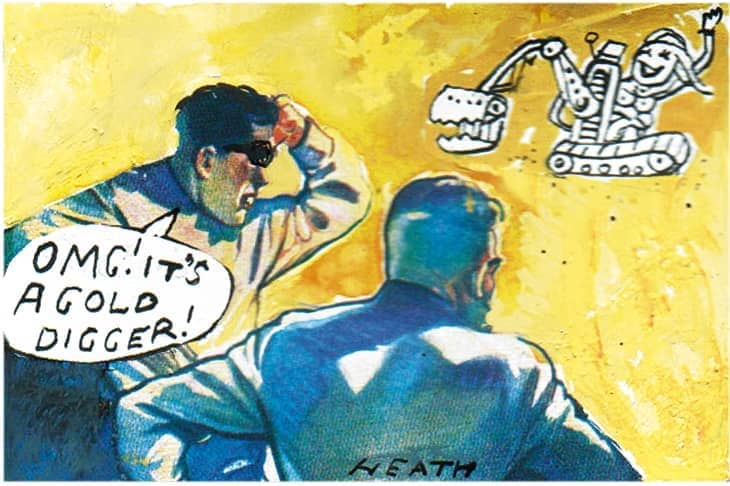After taking James Bond hostage, Auric Goldfinger does what all Bond villains do when in a position of power — he spills the beans. ‘Mr Bond, all my life I have been in love,’ he tells him. ‘I have been in love with gold. I love its colour, its brilliance, its divine heaviness… I ask you, is there any other substance that so rewards its owner?’
You don’t have to be a criminal mastermind to understand what Goldfinger means. The hunger for gold is ancient and shows no signs of abating. The metal’s enduring value is dictated above all by scarcity: it makes up just one 500,000,000th of the Earth’s crust. We could fit all the gold ever mined into a cube with sides of only 22 metres.
Gold was created billions of years ago by nuclear explosions inside or between stars. Some deposits have loitered at the Earth’s core since its formation; others were smashed into the planet’s surface by asteroids. It ended up buried beneath mountains, hidden under seas and scattered along waterways around the world. By current estimates, about 50,000 tonnes (worth more than £2 billion) is yet to be found.
Almost twice as dense as lead, a standard bar of gold weighs about 12kg. Gold, though heavy, is miraculously agile. An ounce of it can be drawn into a wire five miles long, or beaten into a sheet a hundred times thinner than paper. Unlike most materials, it doesn’t corrode, rust or disintegrate. This makes it endlessly recyclable: it’s not impossible that you’re wearing gold which once belonged to King Solomon or Cleopatra.
Many ancient societies believed the metal was divine. The Egyptians called it ‘the flesh of the gods’ and the Inca called it the ‘sweat’ or ‘tears’ of the sun. These solar associations haven’t disappeared: our chemical symbol for gold, Au, comes from the Latin aurum, which derives from aurora, meaning ‘dawn’.
From Tutankhamun to Midas, Augustus the Strong to Louis the Sun King, rulers chose to surround themselves with gold because its ceaselessly shining surfaces are a fitting metaphor for immortality. It’s the reason why, more than 2,000 years ago, gold was bestowed on a baby in a manger — a baby who, not unlike the morning sun, later rose from the dead.
History is littered with the remains of those who tried, and usually failed, to strike gold. The Spanish Conquistadors spent vast sums and spilled huge quantities of blood travelling through South America in search of El Dorado, where gold was said to be as abundant as water. Others tried to manufacture gold in laboratories. This was a driving force behind alchemy, which dominated science and philosophy in parts of the world for thousands of years. Its practitioners craved the ‘philosopher’s stone’ — a miraculous material they believed would help them transmute base metals into gold.
Modern scientists have succeeded where their alchemical ancestors failed. Over the past 40 years, particle accelerators and nuclear reactors have been used to do what giant stars did billions of years ago: transmuting atoms of bismuth, platinum and mercury into tiny quantities of gold.
To produce just one ounce of gold in this way costs one quadrillion dollars. Easier, perhaps, to do it Goldfinger’s way and raid the local gold vault.






Comments